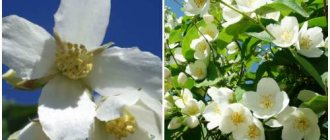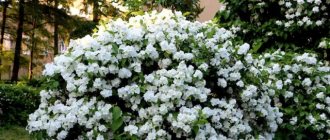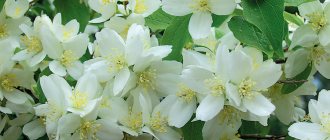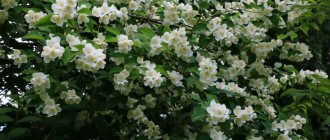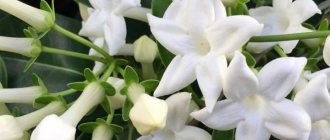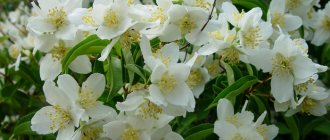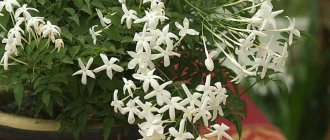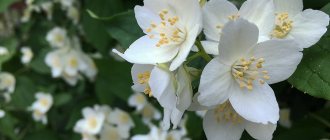Plants of the mock orange family are often called garden or false jasmine. These are ornamental shrubs with light, often white flowers and a delicate aroma, in fact, in some varieties they resemble jasmine.
But among the rest of the family, the Lemoine mock orange variety rightfully occupies an honorable place.
This plant will look good in a garden with lilacs.
Description
Mock orange Lemoine is a beautiful shrub plant belonging to the Hydrangeaceae family. This hybrid category appeared in the 19th century thanks to the French breeder V. Lemoine. Most common in Europe and North America. The plant is a lush bush, reaching 3 meters in height. It is often confused with jasmine, but apart from the pleasant aroma of flowers, there are no common features. The ovoid, lanceolate leaves reach a length of 4 centimeters. The inflorescences are presented in racemes in which large white flowers are collected. Each inflorescence contains 5-7 flowers.
Chubushnik Lemoine - description of the plant
The most popular plants are:
- Glacier mock orange;
- mock orange Charm;
- mock orange Snow storm.
History of selection
Most of the hybrid plants were bred by Victor Lemoine starting in the 19th century. The French breeder and his son Emil created about 40 varieties. The family business lasted approximately 100 years. The varieties developed are still popular among gardeners. Growing jasmines is possible in different climatic conditions due to the main characteristics of the varieties.
It is known that Emile Lemoine began to carry out breeding work along with his father at the age of 16. Victor’s wife also took part in the development. Madame Lemoine is the founder of several varieties of garden jasmine. Their pronounced characteristic is the presence of a pleasant aroma in the flowers.
The varieties are distinguished by the following features:
- non-double;
- original;
- profusely flowering;
- presence of a purple mark.
Lemoine mock orange, the photo and description of which are located below, is successfully grown in Russia due to climatic conditions.
Spreading jasmine bushes have a significant number of arched shoots
Planting a plant
Mock orange virgin - description, planting and care
The seeds are soaked in water for several hours. After this, they are placed in moistened sawdust for 2 days. Before soaking, they should be wrapped in a light cloth. After swelling and germination, the seeds can be prepared for planting. In mock orange they are small, so before planting it is best to mix them with sand, and then place them in pre-prepared grooves and cover them with peat. Planting is also possible in the fall: for this, seeds are placed in prepared grooves and covered with dried grass. Shoots should appear in the spring.
Important! Philadelphus Lemoinei is a light-loving plant.
This representative of the plant world also thrives in areas with light partial shade. Completely shaded areas are undesirable, since in them the branches will begin to stretch, and the bush itself will lose its decorativeness and compactness.
Planting in open ground
Wintering
Rules:
- In the fall, after the bush has completely faded, it needs to be pruned. Sanitary and thinning pruning is usually carried out.
- Additionally, phosphorus-potassium fertilizers should be applied and the tree trunk circle should be mulched with peat or sawdust.
- The mock orange can easily spend the winter without shelter. Even if the frosts are severe and damage the above-ground part of the plant, in the spring the powerful rhizome will be able to give impetus to the development of young shoots.
Planting seedlings in open ground
The optimal time for planting is spring or autumn. In the second case, there must be at least 20 days left before frost, otherwise the bush will not be able to take root before the cold weather arrives.
Mock orange snowbel - description, planting and care
Mock orange is undemanding to soil conditions. Only it cannot be placed on swampy or saline soil. The planting pit is prepared in advance. Its size is 50x60 centimeters. At the bottom there must be a drainage layer and a mixture of garden soil with sand, humus or compost. Additives depend on soil type. When planting several specimens, the distance between the holes should be around 1-1.5 meters.
Remember! When planting, the root collar should be deepened no more than 3 centimeters. Otherwise, rotting may occur. The majority of varieties have sufficient winter hardiness. They can withstand temperatures down to -25°C.
Features of reproduction
Varietal characteristics are not completely transmitted through seeds; various variations will follow. Seeds are sown after stratification or before winter, after the soil freezes. The shrub is easy to grow if the climate suits the varieties.
Mock orange is most often propagated vegetatively:
- cuttings, green or lignified, with small-leaved varieties being better for cuttings;
- a more accessible way is layering;
- The most effective way is to divide the bush.
How to care for Lemoine mock orange
Watering
For good development of the shrub, proper watering is necessary. Young mock oranges need to be moistened once a week. Adult specimens are watered with 15-25 liters of water. Frequency – once every 18-20 days. These recommendations are especially important during dry summers. If a period of heavy rain begins, watering stops. After moistening, loosen the soil and remove weeds.
Top dressing
Chubushnik shneeshturm - description, planting and care
A balanced fertilizer option is a solution of manure in water (1 to 10). This fertilizing is applied in the spring. One bucket is poured under the bush. At the end of the flowering period, wood ash is poured under the bush and leveled.
Reference. You can start applying complex mineral fertilizers only at the 4th year of life!
The proportions of fertilizers are as follows: for each bucket of water, 30 grams of superphosphate are used, as well as 15 grams of potassium sulfate and urea. This volume will be enough for 2 adult mock oranges. After the flowering period, 15 g of potassium sulfate and 25 g of superphosphate are used per square meter.
Trimming
Mock orange should be pruned regularly, otherwise the plant will lose its beauty and cease to please with its lush flowering. The fact is that flowers appear on strong and healthy branches from last year. Flowers may appear on old or diseased branches, but they will be faded and small. Because of this feature, pruning is carried out after flowering has completed. Faded branches are removed before the new shoots of this year. Most often they are located below the trimmed branches.
How to trim correctly
Reference. After a little time, the young branches will begin to grow actively, and dense flowering will begin the next year.
In autumn, sanitary pruning is carried out. Sick and damaged branches are removed, as well as branches that make the bush too dense. Branches older than 12 years are cut out every 3 years. This rejuvenating procedure is carried out in early spring, before sap flow begins. Strong trunks are shortened to 30 centimeters, and all others - to ground level.
Remember! All cuts must be soaked in garden varnish, and the soil must be loosened and mulched. Such measures will ensure strong young shoots and prevent the occurrence of certain diseases.
Reproduction
Mock orange lemoinei reproduces well vegetatively. Reproduction by seeds is also possible, but the use of this method is very doubtful. Flowering in such a plant begins only 5 or 6 years after planting in its permanent habitat, which is very bad. As for varietal characteristics and seed germination, everything is not very good here either. Seeds, as a rule, rarely retain parental and varietal characteristics, and their germination rate is low and short-lived.
Reproduction
The best options are the following propagation methods:
- cuttings;
- layering;
- division.
Cuttings
With the beginning of the first month of summer, green cuttings are cut off from the mock orange and rooted. When cutting, the green shoot should be left with part of the branch from last year's growth. There should be 2 pairs of leaves left on the cuttings. The top ones are cut by 1/3 or 1/2, and the bottom ones are completely removed.
Material for planting can be made in the fall. After this, it is placed in a regular bag and sent to the refrigerator until spring. Starting from the 2nd half of March, blanks 5 centimeters long are cut from these shoots. After this, they need to be kept in a solution of a root-forming stimulant for one day.
Cuttings
To root, cuttings must be buried in sandy soil or sand in the open air. Another option is to use a potty. For good rooting you will need warmth, soil and air with high humidity. To achieve all these conditions, a mini-greenhouse is suitable.
Advice. An ordinary plastic bottle is suitable for making a mini-greenhouse. To do this, you need to cut it in half and take the upper part. After planting the cutting, cover it with this part, not forgetting to unscrew the lid to allow air to enter.
Rooted cuttings will make excellent seedlings by next spring.
Description of mock orange at flowering time: height of the bush, photo of leaves and flowers
The mock orange plant or garden jasmine (Philadelphus) belongs to the Hydrangeaceae family, its homeland is Europe, East and Southeast Asia, and North America. It is found over a large area from the Caucasus to the regions of Southern Europe.
In Russia, this shrub is often incorrectly called jasmine due to the pronounced sweet aroma of flowers in some types of mock orange. True jasmines are subtropical evergreen climbing and creeping plants from the Olive family. What brings real jasmines and mock oranges together is the similarity of the aroma of the flowers, although among more than 50 species of mock orange there are representatives with a very weak aroma or no scent of flowers at all (large-flowered, Schrenk, Gordon).
Garden jasmine is an amazing ornamental shrub, which for some reason can rarely be found in garden plots in recent years (the exception being those that are more than a quarter of a century old). But it can be used as a hedge that separates two neighboring plots, and simply as a decoration for any corner of the garden.
This is a spreading, multi-stemmed, deciduous, erect shrub. The height of the mock orange ranges from 0.8 to 3.5 - 4 m, the bushes have a spherical crown.
The leaves of mock orange are opposite, ovate-lanceolate or oval-pointed. The shoots are bare and are used to make chibouks (smoking pipes), hence its name. In spring, the yellow leaves of the bush begin to turn green, and by autumn the bush loses them.
Mock orange flowers are white or cream-colored, up to 5 cm in diameter, collected in racemes or paniculate inflorescences, strongly or weakly fragrant, often double. Blooms in summer, from late June to July; some species and varieties bloom for up to 7 weeks.
As you can see in the photo, the fruit of the mock orange bush is a capsule with small seeds:
Mock orange is valued for the beauty and delicate aroma of its flowers.
The garden jasmine plant prefers open sunny places and, although it can tolerate partial shade, it stops blooming in strong shade. They are very demanding on soil moisture and fertility, so during the growing process they should be regularly fed with organic and mineral fertilizers. They do not tolerate close stagnation of groundwater. They respond well to pruning and are easily propagated by root suckers, layering, green and woody cuttings, dividing the bush and unstratified seeds, which can be sown in the fall, in the snow and in the spring.
Chubushnik has sufficient winter hardiness, however, different species and varieties can behave differently in the climatic conditions of Central Russia. Now any planting material of these shrubs can reach our market. Therefore, it is dangerous to indiscriminately purchase species and varieties of foreign origin: some of them tolerate frosts down to -25°C, while others can withstand only -15°C. In particularly harsh winters, even winter-hardy species and varieties can freeze to the level of the snow cover, but thanks to the presence of a powerful root system, the frostbitten bush quickly grows back after pruning the damaged shoots. It is more difficult for less winter-hardy varieties and species in which the root system may freeze to recover.
The duration of mock orange flowering depends on its variety. Sometimes it blooms for two months! The flowers of mock orange are quite large: in modern varieties they can reach 6 cm in diameter. Of particular value is the flowering period of mock orange - June-July, when most garden crops have already faded.
But before and after flowering, it does not create any beauty in the area, because the bush is ugly, long-legged, upright with branches absurdly sticking out in all directions. Therefore, there is no need to put it in the foreground.
Transplants can be carried out at any time throughout the summer, but the root system should not dry out. The plant requires attention: every year you need to cut out outdated, lignified branches, broken and frozen. As soon as you stop watching it, it will very quickly take on the appearance of a homeless tramp.
Diseases and pests
Mock orange is a disease-resistant plant. Problems with it can arise due to harmful insects.
Diseases and pests
The most frequent guests on the plant:
- bean aphid;
- spider mite;
- green leaf weevil.
To exterminate aphids, the drugs Karbofos or Rogor are used, according to the instructions.
To get rid of spider mites, you will need a 3% Keltan emulsion or a 2% Phosfamide solution. These products should be sprayed on the plants and the soil underneath them. Frequency – 2-3 times with a break per week.
Remember! To remove the weevil and its offspring, you need to spray the soil and bushes with Chlorophos.
Preparing for winter
When the mock orange has finished blooming, it is prepared for wintering. Autumn pruning is carried out: diseased and dense branches are removed. After this, the mock orange is fed with phosphorus-potassium fertilizers and mulched. A thick layer of sawdust or peat is suitable for this.
The plant does not need shelter for the winter. As mentioned earlier, mock orange tolerates frosts down to -25°C. Even if some shoots freeze, the bush will not die. In spring, dead shoots are pruned to stimulate the growth of new shoots.
Main characteristics
A popular landscape shrub, rich in different varieties, created by the Lemoine family and other breeders, withstands the winters of the middle zone quite steadfastly. When purchasing seedlings, it is worth checking the correct name of the variety to determine its frost resistance. There are specimens that overwinter without shelter. After severe frosts, most mock orange trees grow well and grow green mass and wood. But some foreign varieties are heat-loving and suffer greatly in winter.
Mock oranges are not susceptible to common diseases, but the leaves are plagued by various pests. Insecticides are used against insects.
Use in landscape design
You can achieve harmony in landscape design by combining mock orange with hydrangea, viburnum or dogwood.
A special place is occupied by dwarf shrubs, such as “Gnome” and “Dwarf”. Such varieties are used as living borders, as well as edging flower beds and mixborders.
Use in landscape design
Mock oranges “Abundance”, “Chamomile”, “Avalanche” look very good in flower beds and mixborders. It is logical to use them in sensory gardens - aroma gardens, because of the wonderful smell of flowers.
For hedges, the varieties “Glacier”, “Moonlight”, and “Obelisk” are used.
Remember! The possibilities for using Lemoine mock orange in landscape design are enormous. The main thing to remember is that this is a fast-growing plant. Without proper care and rejuvenating procedures, it can quickly lose its decorative qualities.
Beneficial features
The plant itself is not medicinal, but research is still underway. Essential oils, phytoncides, acids, vitamins C, E, PP and a small amount of glycosides were found in mock orange.
As a result, we get a plant with tonic, analgesic, antiseptic and regenerating properties. There are several traditional medicine recipes with this plant, but before using it, it is better to consult with a knowledgeable specialist.
Thus, mock orange is an amazing plant. Each species has a whole bunch of varieties, so choosing a plant to suit your purposes will not be difficult. Beautiful flowering and amazing aroma will not leave plant lovers aside!

